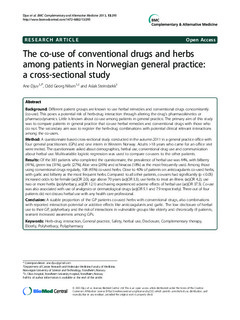| dc.contributor.author | Djuv, Ane | |
| dc.contributor.author | Nilsen, Odd Georg | |
| dc.contributor.author | Steinsbekk, Aslak | |
| dc.date.accessioned | 2019-10-29T14:32:08Z | |
| dc.date.available | 2019-10-29T14:32:08Z | |
| dc.date.created | 2014-01-03T12:16:06Z | |
| dc.date.issued | 2013 | |
| dc.identifier.citation | BMC Complementary and Alternative Medicine. 2013, 13 295-306. | nb_NO |
| dc.identifier.issn | 1472-6882 | |
| dc.identifier.uri | http://hdl.handle.net/11250/2625216 | |
| dc.description.abstract | Background
Different patient groups are known to use herbal remedies and conventional drugs concomitantly (co-use). This poses a potential risk of herb-drug interaction through altering the drug’s pharmacokinetics or pharmacodynamics. Little is known about co-use among patients in general practice. The primary aim of this study was to compare patients in general practice that co-use herbal remedies and conventional drugs with those who do not. The secondary aim was to register the herb-drug combinations with potential clinical relevant interactions among the co-users.
Method
A questionnaire based cross-sectional study conducted in the autumn 2011 in a general practice office with four general practitioners (GPs) and one intern in Western Norway. Adults >18 years who came for an office visit were invited. The questionnaire asked about demographics, herbal use, conventional drug use and communication about herbal use. Multivariable logistic regression was used to compare co-users to the other patients.
Results
Of the 381 patients who completed the questionnaire, the prevalence of herbal use was 44%, with bilberry (41%), green tea (31%), garlic (27%), Aloe vera (26%) and echinacea (18%) as the most frequently used. Among those using conventional drugs regularly, 108 (45%) co-used herbs. Close to 40% of patients on anticoagulants co-used herbs, with garlic and bilberry as the most frequent herbs. Compared to all other patients, co-users had significantly (p < 0.05) increased odds to be female (adjOR 2.0), age above 70 years (adjOR 3.3), use herbs to treat an illness (adjOR 4.2), use two or more herbs (polyherbacy, adjOR 12.1) and having experienced adverse effects of herbal use (adjOR 37.5). Co-use was also associated with use of analgesics or dermatological drugs (adjOR 5.1 and 7.9 respectively). Three out of four patients did not discuss herbal use with any health care professional.
Conclusion
A sizable proportion of the GP patients co-used herbs with conventional drugs, also combinations with reported interaction potential or additive effects like anticoagulants and garlic. The low disclosure of herbal use to their GP, polyherbacy and the risk of interactions in vulnerable groups like elderly and chronically ill patients, warrant increased awareness among GPs. | nb_NO |
| dc.language.iso | eng | nb_NO |
| dc.publisher | BMC (part of Springer Nature) | nb_NO |
| dc.rights | Navngivelse 4.0 Internasjonal | * |
| dc.rights.uri | http://creativecommons.org/licenses/by/4.0/deed.no | * |
| dc.title | The co-use of conventional drugs and herbs among patients in Norwegian general practice: a cross-sectional study | nb_NO |
| dc.type | Journal article | nb_NO |
| dc.type | Peer reviewed | nb_NO |
| dc.description.version | publishedVersion | nb_NO |
| dc.source.pagenumber | 295-306 | nb_NO |
| dc.source.volume | 13 | nb_NO |
| dc.source.journal | BMC Complementary and Alternative Medicine | nb_NO |
| dc.identifier.doi | 10.1186/1472-6882-13-295 | |
| dc.identifier.cristin | 1083085 | |
| dc.description.localcode | © 2013 Djuv et al.; licensee BioMed Central Ltd. This is an open access article distributed under the terms of the Creative Commons Attribution License (http://creativecommons.org/licenses/by/2.0), which permits unrestricted use, distribution, and reproduction in any medium, provided the original work is properly cited. | nb_NO |
| cristin.unitcode | 1920,0,0,0 | |
| cristin.unitcode | 194,65,15,0 | |
| cristin.unitcode | 194,65,20,0 | |
| cristin.unitname | St. Olavs Hospital HF | |
| cristin.unitname | Institutt for klinisk og molekylær medisin | |
| cristin.unitname | Institutt for samfunnsmedisin og sykepleie | |
| cristin.ispublished | true | |
| cristin.fulltext | original | |
| cristin.qualitycode | 2 | |

